Aston Martin theme by Davino
Download: AstonMartin_2.p3t
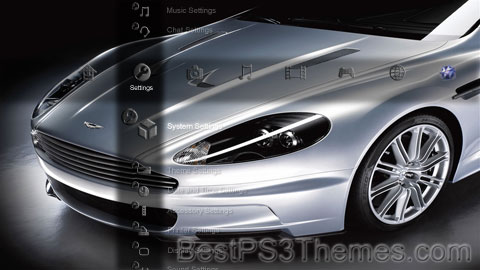
(1 background)
 | |
| Company type | Public limited company |
|---|---|
| LSE: AML FTSE 250 component | |
| ISIN | GB00BFXZC448 |
| Industry | Automotive |
| Founded | 15 January 1913 |
| Founders | |
| Headquarters | Gaydon, Warwickshire, England, United Kingdom |
Area served | Worldwide |
Key people |
|
| Products | |
| Brands |
|
| Revenue | |
| Subsidiaries | Aston Martin Racing |
| Website | astonmartinlagonda.com |
Aston Martin Lagonda Global Holdings PLC (/ˈæstən/) is a British manufacturer of luxury sports cars and grand tourers. Its predecessor was founded in 1913 by Lionel Martin and Robert Bamford. Steered from 1947 by David Brown, it became associated with expensive grand touring cars in the 1950s and 1960s, and with the fictional character James Bond following his use of a DB5 model in the 1964 film Goldfinger.[2] Their grand tourers and sports cars are regarded as a British cultural icon.[3]
Aston Martin has held a royal warrant as purveyor of motorcars to Charles III (as Prince of Wales and later as King) since 1982,[4][5] and has over 160 car dealerships in 53 countries, making it a global automobile brand.[6] The company is traded on the London Stock Exchange and is a constituent of the FTSE 250 Index.[7] In 2003 it received the Queen's Award for Enterprise for outstanding contribution to international trade.[8] The company has survived seven bankruptcies throughout its history.[9]
The headquarters and main production of its sports cars and grand tourers are in a 55-acre (22 ha) facility in Gaydon, Warwickshire, England, on the former site of RAF Gaydon, adjacent to the Jaguar Land Rover Gaydon Centre.[10] The old 3.6-acre (1.5 ha) facility in Newport Pagnell, Buckinghamshire is the present home of the Aston Martin Works classic car department, which focuses on heritage sales, service, spares and restoration operations.[11][12] The 90-acre (36 ha) factory in St Athan, Wales features three converted 'super-hangars' from MOD St Athan, and serves as the production site of Aston Martin's first-ever SUV, the DBX.[13][14]
Aston Martin has been involved in motorsport at various points in its history, mainly in sports car racing,[15] and also in Formula One.[16] The Aston Martin brand is increasingly being used, mostly through licensing, on other products including a submarine,[17] real estate development,[18] and aircraft.[19]
History[edit]
Founding[edit]
Aston Martin was founded in 1913 by Lionel Martin and Robert Bamford.[20] The two had joined forces as Bamford & Martin the previous year to sell cars made by Singer from premises in Callow Street, London where they also serviced GWK and Calthorpe vehicles. Martin raced specials at Aston Hill near Aston Clinton, and the pair decided to make their own vehicles.[21] The first car to be named Aston Martin was created by Martin by fitting a four-cylinder Coventry-Simplex engine to the chassis of a 1908 Isotta Fraschini.[22][23]
They acquired premises at Henniker Mews[24] in Kensington and produced their first car in March 1915. Production could not start because of the outbreak of the First World War, when Martin joined the Admiralty and Bamford joined the Army Service Corps.[25]
1918–1939: Interwar years[edit]
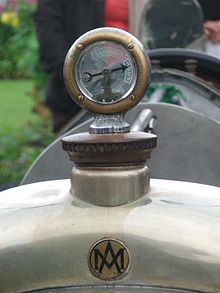

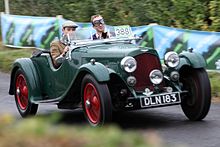
After the war they found new premises at Abingdon Road, Kensington and designed a new car. Bamford left in 1920 and Bamford & Martin was revitalised with funding from Louis Zborowski. In 1922, Bamford & Martin produced cars to compete in the French Grand Prix, which went on to set world speed and endurance records at Brooklands. Three works Team Cars with 16-valve twin cam engines were built for racing and record-breaking: chassis number 1914, later developed as the Green Pea; chassis number 1915, the Razor Blade record car; and chassis number 1916, later developed as the Halford Special.[26]
Approximately 55 cars were built for sale in two configurations; long chassis and short chassis. Bamford & Martin went bankrupt in 1924 and was bought by Dorothea, Lady Charnwood, who put her son John Benson on the board. Bamford & Martin got into financial difficulty again in 1925 and Martin was forced to sell the company (Bamford had already left it in 1920).[27]
Later that year, Bill Renwick, Augustus (Bert) Bertelli and investors including Lady Charnwood took control of the business. They renamed it Aston Martin Motors and moved it to the former Whitehead Aircraft Limited Hanworth works in Feltham. Renwick and Bertelli had been in partnership some years and had developed an overhead-cam four-cylinder engine using Renwick's patented combustion chamber design, which they had tested in an Enfield-Allday chassis. The only "Renwick and Bertelli" motor car made, it was known as "Buzzbox" and still survives.[28]
The pair had planned to sell their engine to motor manufacturers, but having heard that Aston Martin was no longer in production realised they could capitalise on its reputation to jump-start the production of a completely new car.[28]
Between 1926 and 1937 Bertelli was both technical director and designer of all new Aston Martins, since known as "Bertelli cars". They included the 1½-litre "T-type", "International", "Le Mans", "MKII" and its racing derivative, the "Ulster", and the 2-litre 15/98 and its racing derivative, the "Speed Model". Most were open two-seater sports cars bodied by Bert Bertelli's brother Enrico (Harry), with a small number of long-chassis four-seater tourers, dropheads and saloons also produced.[28]
Bertelli was a competent driver keen to race his cars, one of few owner/manufacturer/drivers. The "LM" team cars were very successful in national and international motor racing including at Le Mans.[28]
Financial problems reappeared in 1932. Aston Martin was rescued for a year by Lance Prideaux Brune before passing it on to Sir Arthur Sutherland. In 1936, Aston Martin decided to concentrate on road cars, producing just 700 until World War II halted work. Production shifted to aircraft components during the war.[29][30]
1947–1972: David Brown[edit]
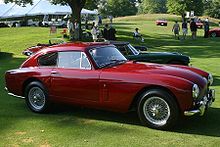
In 1947, old-established (1860) privately owned Huddersfield gear and machine tools manufacturer David Brown Limited bought Aston Martin, putting it under control of its Tractor Group. David Brown became Aston Martin's latest saviour.[31] He also acquired Lagonda,[32] without its factory, for its 2.6-litre W. O. Bentley-designed engine. Lagonda moved operations to Newport Pagnell and shared engines, resources and workshops. Aston Martin began to build the classic "DB" series of cars.[33]
In April 1950, they announced planned production of their Le Mans prototype to be called the DB2,[34] followed by the DB2/4 in 1953, the DB2/4 MkII in 1955, the DB Mark III in 1957 and the Italian-styled 3.7 L DB4 in 1958.[33]
While these models helped Aston Martin establish a good racing pedigree, the DB4 stood out and yielded the famous DB5 in 1963. Aston stayed true to its grand touring style with the DB6 (1965–70), and DBS (1967–1972).[33]
The six-cylinder engines of these cars from 1954 up to 1965 were designed by Tadek Marek.[35]
1972–1975: William Willson[edit]
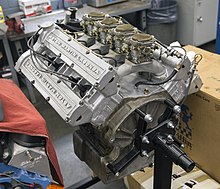
Aston Martin was often financially troubled. In 1972, David Brown paid off all its debts, said to be £5 million or more, and handed it for £101 to Company Developments, a Birmingham-based investment bank consortium chaired by accountant William Willson.[36] More detail on this period may be read at Willson's biography. The worldwide recession, lack of working capital and the difficulties of developing an engine to meet California's exhaust emission requirements – it stopped the company's US sales – again pulled Aston Martin into receivership at the end of 1974. The company had employed 460 workers when the manufacturing plant closed.[37]
1975–1981: Sprague and Curtis[edit]
The receiver sold the business in April 1975 for £1.05 million to North American businessman Peter Sprague of National Semiconductor, Toronto hotelier George Minden,[38] and Jeremy Turner, a London businessman,[39] who insisted to reporters that Aston Martin remained a British controlled business. Sprague later claimed he had fallen in love with the factory, not the cars, the workforce's craftsmanship dedication and intelligence. At this point, he and Minden had brought in investor Alan Curtis, a British office property developer, together with George Flather, a retired Sheffield steel magnate.[40]
Six months later, in September 1975, the factory – shut down the previous December – re-opened under its new owner as Aston Martin Lagonda Limited with 100 employees, and planned to lift staff to 250 by the end of 1975.[37] In January 1976, AML revealed that it now held orders for 150 cars for the US, 100 for other markets and another 80 from a Japanese importing agency.[41] At the Geneva Motor Show, Fred Hartley, managing director and sales director for 13 years before that, announced he had resigned over "differences in marketing policy".[42]
The new owners pushed Aston Martin into modernising its line, introducing the V8 Vantage in 1977, the convertible Volante in 1978, and the one-off Bulldog styled by William Towns in 1980. Towns also styled the futuristic new Lagonda saloon, based on the V8 model.[43]
Curtis, who had a 42% stake in Aston Martin,[44] also brought about a change in direction from the usual customers who were Aston Martin fans, to successful young married businessmen. Prices had been increased by 25%.[40] There was speculation that AML was about to buy Italian automobile manufacturer Lamborghini.[45] At the end of the 1970s, there was widespread debate about running MG into the Aston Martin consortium. 85 Conservative MPs formed themselves into a pressure group to get British Leyland to release their grip and hand it over.[46] CH Industrials plc (car components) bought a 10% share in AML. But in July 1980, blaming a recession, AML cut back their workforce of 450 by more than 20%, making those people redundant.[47]
1981–1987: Victor Gauntlett[edit]
In January 1981, there having been no satisfactory revival partners, Alan Curtis and Peter Sprague announced they had never intended to maintain a long-term financial stake in Aston Martin Lagonda and it was to be sold to Pace Petroleum's Victor Gauntlett. Sprague and Curtis pointed out that under their ownership AML finances had improved to where an offer for MG might have been feasible.[48]
Gauntlett bought a 12.5% stake in Aston Martin for £500,000 via Pace Petroleum in 1980, with Tim Hearley of CH Industrials taking a similar share. Pace and CHI took over as joint 50/50 owners at the beginning of 1981, with Gauntlett as executive chairman. Gauntlett also led the sales team, and after some development and publicity when the Lagonda became the world's fastest four-seater production car, was able to sell the car in Oman, Kuwait, and Qatar.[49] In 1982, Aston Martin was granted a Royal Warrant of Appointment by the Prince of Wales.[5]
Understanding that it would take some time to develop new Aston Martin products, they created an engineering service subsidiary to develop automotive products for other companies. It was decided to use a trade name of Salmons & Son, their in-house coachbuilder, Tickford, which Aston Martin had bought in 1955. Tickford's name had been long associated with expensive high-quality carriages and cars along with their folding roofs. New products included a Tickford Austin Metro, a Tickford Ford Capri and even Tickford train interiors, particularly on the Jaguar XJS.[49] Pace continued sponsoring racing events, and now sponsored all Aston Martin Owners Club events, taking a Tickford-engined Nimrod Group C car owned by AMOC President Viscount Downe, which came third in the Manufacturers Championship in both 1982 and 1983. It also finished seventh in the 1982 24 Hours of Le Mans race. However, sales of production cars were now at an all-time low of 30 cars produced in 1982.[49]

As trading became tighter in the petroleum market, and Aston Martin was requiring more time and money, Gauntlett agreed to sell Hays/Pace to the Kuwait Investment Office in September 1983. As Aston Martin required greater investment, he also agreed to sell his share holding to American importer and Greek shipping tycoon Peter Livanos, who invested via his joint venture with Nick and John Papanicolaou, ALL Inc. Gauntlett remained chairman of AML, 55% of the stake was owned by ALL, with Tickford a 50/50 venture between ALL and CHI. The uneasy relationship was ended when ALL exercised options to buy a larger share in AML; CHI's residual shares were exchanged for CHI's complete ownership of Tickford, which retained the development of existing Aston Martin projects. In 1984, Papanicolaou's Titan shipping business was in trouble so Livanos's father George bought out the Papanicolaou's shares in ALL, while Gauntlett again became a shareholder with a 25% holding in AML. The deal valued Aston Martin/AML at £2 million, the year it built its 10,000th car.[49]
Although as a result Aston Martin had to make 60 members of the workforce redundant, Gauntlett bought a stake in Italian styling house Zagato, and resurrected its collaboration with Aston Martin.[50] In 1986, Gauntlett negotiated the return of the fictional British secret agent James Bond to Aston Martin. Cubby Broccoli had chosen to recast the character using actor Timothy Dalton, in an attempt to re-root the Bond-brand back to a more Sean Connery-like feel. Gauntlett supplied his personal pre-production Vantage for use in the filming of The Living Daylights, and sold a Volante to Broccoli for use at his home in America. Gauntlett turned down the role of a KGB colonel in the film, however: "I would have loved to have done it but really could not afford the time."[51]
1987–2007: Ford Motor Company[edit]
As Aston Martin needed funds to survive in the long term, Ford bought a 75% stake in the company in 1987, and bought the rest later.[52][53] In May of that year, Victor Gauntlett and Prince Michael of Kent were staying at the home of Contessa Maggi, the wife of the founder of the original Mille Miglia, while watching the revival event. Another house guest was Walter Hayes, vice-president of Ford of Europe. Despite problems over the previous acquisition of AC Cars, Hayes saw the potential of the brand and the discussion resulted in Ford taking a share holding in September 1987.[54] In 1988, having produced some 5,000 cars in 20 years, a revived economy and successful sales of limited edition Vantage, and 52 Volante Zagato coupés at £86,000 each; Aston Martin finally retired the ancient V8 and introduced the Virage range.[55]
Although Gauntlett was contractually to stay as chairman for two years, his racing interests took the company back into sports car racing in 1989 with limited European success. However, with engine rule changes for the 1990 season and the launch of the new Volante model, Ford provided the limited supply of Cosworth engines to the Jaguar cars racing team. As the entry-level DB7 would require a large engineering input, Ford agreed to take full control of Aston Martin, and Gauntlett handed over Aston Martin's chairmanship to Hayes in 1991.[56] In 1992, the high-performance variant of the Virage called the Vantage was announced, and the following year Aston Martin renewed the DB range by announcing the DB7.[57]
By 1993, Ford had fully acquired the company after having built a stake in 1987.[58] Ford placed Aston Martin in the Premier Automotive Group, invested in new manufacturing and ramped up production. In 1994, Ford opened a new factory at Banbury Road in Bloxham to manufacture the DB7. In 1995, Aston Martin produced a record 700 cars.[59] Until the Ford era, cars had been produced by hand coachbuilding craft methods, such as the English wheel. During the mid 1990s, the Special Projects Group, a secretive unit with Works Service at Newport Pagnell, created an array of special coach-built vehicles for the Brunei royal family.[60] In 1998, the 2,000th DB7 was built, and in 2002, the 6,000th, exceeding production of all of the previous DB series models. The DB7 range was revamped by the addition of more powerful V12 Vantage models in 1999, and in 2001, Aston Martin introduced the V12-engined flagship model called the Vanquish which succeeded the aging Virage (now called the V8 Coupé).[61]

At the North American International Auto Show in Detroit, Michigan in 2003, Aston Martin introduced the V8 Vantage concept car. Expected to have few changes before its introduction in 2005, the Vantage brought back the classic V8 engine to allow Aston Martin to compete in a larger market. 2003 also saw the opening of the Gaydon factory, the first purpose-built factory in Aston Martin's history. The facility is situated on a 55-acre (22 ha) site of a former RAF V Bomber airbase, with an 8,000 m2 (86,000 sq ft) front building for offices, meeting rooms and customer reception, and a 35,000 m2 (380,000 sq ft) production building.[10][62] Also introduced in 2003 was the DB9 coupé, which replaced the ten-year-old DB7. A convertible version of the DB9, the DB9 Volante, was introduced at the 2004 Detroit auto show.[63]
In October 2004, Aston Martin set up the dedicated 12,500 m2 (135,000 sq ft) Aston Martin Engine Plant (AMEP) within the Ford Germany Niehl, Cologne plant. With the capacity to produce up to 5,000 engines a year by 100 specially trained personnel, like traditional Aston Martin engine production from Newport Pagnell, assembly of each unit was entrusted to a single technician from a pool of 30, with V8 and V12 variants assembled in under 20 hours. By bringing engine production back to within Aston Martin, the promise was that Aston Martin would be able to produce small runs of higher performance variants' engines.[64][65] This expanded engine capacity allowed the entry-level V8 Vantage sports car to enter production at the Gaydon factory in 2006, joining the DB9 and DB9 Volante.[66]
In December 2003, Aston Martin announced it would return to motor racing in 2005. A new division was created, called Aston Martin Racing, which became responsible, together with Prodrive, for the design, development, and management of the DBR9 program. The DBR9 competes in the GT class in sports car races, including the world-famous 24 Hours of Le Mans.[67]
In 2006, an internal audit led Ford to consider divesting itself of parts of its Premier Automotive Group. After suggestions of selling Jaguar Cars, Land Rover, or Volvo Cars were weighed, Ford announced in August 2006 it had engaged UBS AG to sell all or part of Aston Martin at auction.[68]
2007–2018: Private Limited Company[edit]
On 12 March 2007, a consortium led by Prodrive chairman David Richards purchased Aston Martin for £475 million (US$848 million).[69][70][71] The group included American investment banker John Sinders and two Kuwaiti companies namely Investment Dar and Adeem Investment.[72]
